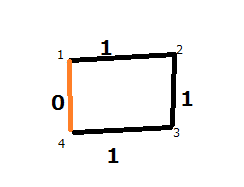To find shortest path in a directed graph with edges having weight either 0 or 1 , we often use a modification of bfs with deque. But i don't know why we push at head of the queue whenever we encounter a 0-weight edge ?
→ Обратите внимание
До соревнования
CodeTON Round 9 (Div. 1 + Div. 2, Rated, Prizes!)
26:06:54
Зарегистрироваться »
CodeTON Round 9 (Div. 1 + Div. 2, Rated, Prizes!)
26:06:54
Зарегистрироваться »
*есть доп. регистрация
→ Лидеры (рейтинг)
| № | Пользователь | Рейтинг |
|---|---|---|
| 1 | tourist | 4009 |
| 2 | jiangly | 3823 |
| 3 | Benq | 3738 |
| 4 | Radewoosh | 3633 |
| 5 | jqdai0815 | 3620 |
| 6 | orzdevinwang | 3529 |
| 7 | ecnerwala | 3446 |
| 8 | Um_nik | 3396 |
| 9 | ksun48 | 3390 |
| 10 | gamegame | 3386 |
| Страны | Города | Организации | Всё → |
→ Лидеры (вклад)
| № | Пользователь | Вклад |
|---|---|---|
| 1 | cry | 167 |
| 2 | Um_nik | 163 |
| 3 | maomao90 | 162 |
| 3 | atcoder_official | 162 |
| 5 | adamant | 159 |
| 6 | -is-this-fft- | 158 |
| 7 | awoo | 157 |
| 8 | TheScrasse | 154 |
| 9 | Dominater069 | 153 |
| 9 | nor | 153 |
→ Найти пользователя
→ Прямой эфир
↑
↓
Codeforces (c) Copyright 2010-2024 Михаил Мирзаянов
Соревнования по программированию 2.0
Время на сервере: 22.11.2024 15:28:07 (k2).
Десктопная версия, переключиться на мобильную.
При поддержке
Списки пользователей


| Название |
|---|











https://www.hackerearth.com/alkhwarizm15/algorithm/completing-mario/
This problem explains the scenario better.
This problem appeared in alkhwarizm 2015. Although i solved it using dijkstra but as you mentioned that this problem can be solved using bfs by pushing the 0 weight edge at the head of the queue.
idea is very very simple. When you know explore level X in the bfs all the nodes which are level X-1 are already in queue right ? In this case from level X you might have explored level X again with an edge having weight 0 and then X+1 using edge with weight 1. putting the X level node at the end of queue will lead to inconsistency as there might be a scenario in the queue like this {X,X+1,X,X+1} (entries represents levels) but if you put the level explored through edge weight 0 it will not hinder the consistency in the queue and preforms desired work
thanks, can u give me a test case where this type of scenario occurs and where it becomes necessary to add 0-weight edge at the head of the queue ?
Typical BFS never visits same nodes again so something like this should be nice example.
You start in the node 1.
After that you push node 2 and node 4 into your queue.
After that you pop node 2 and push node 3.
After that you pop node 4 and do not push node 3 again.
You can optimize this by pushing 3 again with path relaxing way like if (d[3] < d[4] + 1) push(3)
But it's not hard to prove that if you really do this there is a graph where your BFS will not work in O(E) complexity
Hope this helps you.
thanks ,it really helped :D ...